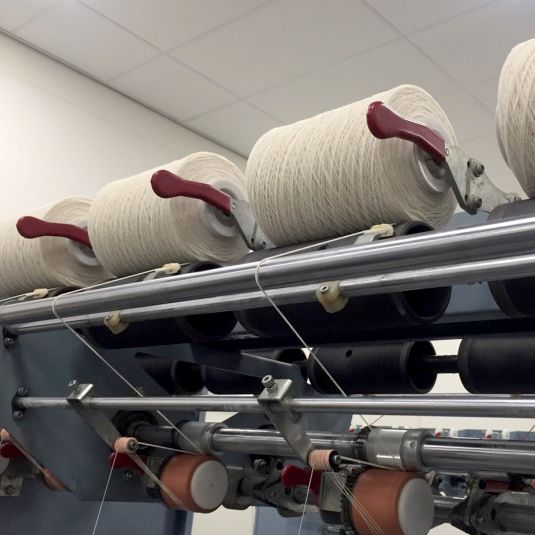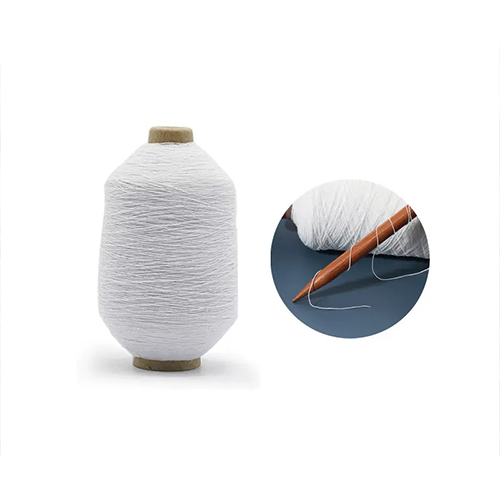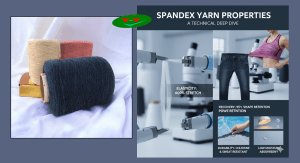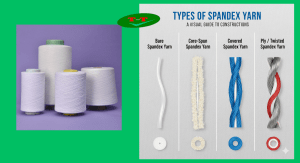Covering yarn has revolutionized the textile industry, offering a unique blend of functionality and aesthetics that has captivated manufacturers and consumers alike. This innovative product combines the strength and elasticity of spandex with the diverse properties of other fibers, resulting in a versatile material that has found applications in various sectors. From sportswear to high-fashion garments, covering yarn has become an indispensable component in the creation of comfortable, durable, and stylish fabrics. Its ability to enhance the performance of textiles while maintaining a smooth and uniform appearance has made it a go-to choice for designers and textile engineers seeking to push the boundaries of fabric technology.
Covering Yarn

Covering yarn represents a significant advancement in textile manufacturing, combining the best qualities of multiple fibers to create a superior product. At its core, covering yarn consists of a central elastic core, typically made of spandex or elastane, which is then wrapped or covered with one or more layers of a different fiber. This unique construction allows for the creation of fabrics that possess both stretch and recovery properties, along with the desirable characteristics of the covering fiber.
The Evolution of Covering Yarn
The development of covering yarn can be traced back to the mid-20th century, coinciding with the invention of spandex fibers. As textile manufacturers sought ways to incorporate the revolutionary elasticity of spandex into a wider range of fabrics, the concept of covering these elastic cores with other fibers emerged. This innovation addressed the challenges of working directly with bare spandex, which can be difficult to handle and process in traditional textile machinery.
The evolution of covering yarn has been driven by continuous technological advancements and changing market demands. Early versions of covering yarn were primarily focused on functionality, with less emphasis on aesthetics. However, as the textile industry progressed, manufacturers began to experiment with different covering fibers and techniques, leading to a diverse range of products that could meet both performance and appearance requirements.
Today, covering yarn has become an integral part of many high-performance fabrics, particularly in the sportswear and athleisure markets. Its ability to provide comfort, fit, and durability has made it indispensable in the creation of garments that need to withstand rigorous use while maintaining their shape and appearance.
Applications of Covering Yarn
The versatility of covering yarn has led to its adoption across a wide spectrum of textile applications. In the realm of sportswear, covering yarn is used extensively in the production of compression garments, swimwear, and athletic uniforms. These applications benefit from the yarn’s ability to provide a snug fit that moves with the body while offering moisture-wicking and quick-drying properties when combined with synthetic covering fibers.
Beyond athletics, covering yarn has found its place in the fashion industry, where it is used to create form-fitting garments that offer both comfort and style. Denim manufacturers have embraced covering yarn to produce stretch jeans that retain their shape even after prolonged wear. In the lingerie sector, covering yarn enables the creation of delicate yet supportive undergarments that combine aesthetics with functionality.
The medical textile industry has also recognized the value of covering yarn, utilizing it in the production of compression stockings, bandages, and other therapeutic garments. The controlled elasticity provided by covering yarn allows for the precise application of pressure, aiding in the treatment of various circulatory and lymphatic conditions.
Advantages of Using Covering Yarn
Improved fabric performance is one of the primary benefits of incorporating covering yarn into textile production. The elastic core provides stretch and recovery properties, allowing garments to conform to the body’s movements and return to their original shape. This characteristic not only enhances comfort but also extends the lifespan of the garment by reducing bagging and sagging.
Enhanced durability is another significant advantage of covering yarn. The outer layer of fibers protects the elastic core from abrasion and degradation, resulting in fabrics that can withstand repeated washing and wear without losing their elasticity or appearance. This durability makes covering yarn an economical choice for manufacturers and consumers alike.
Versatility in design is perhaps one of the most appealing aspects of covering yarn for textile designers. By selecting different covering fibers, manufacturers can create fabrics with a wide range of textures, colors, and performance characteristics. This flexibility allows for the development of innovative textiles that can meet specific market needs or fashion trends.
As the textile industry continues to evolve, covering yarn remains at the forefront of fabric innovation. Its unique properties and adaptability ensure that it will play a crucial role in the development of next-generation textiles, addressing the ever-changing demands of consumers for performance, comfort, and style.
Yarn Covering Process
The yarn covering process is a sophisticated technique that involves wrapping a core yarn, typically made of elastic material like spandex, with one or more layers of covering fibers. This process is fundamental to creating covered yarns that combine the elasticity of the core with the desirable properties of the covering material. Understanding the intricacies of this process is crucial for textile manufacturers seeking to produce high-quality covered yarns for various applications.
Preparation of Core and Covering Fibers
Before the actual covering process begins, careful preparation of both the core and covering fibers is essential. The elastic core, usually spandex, must be selected based on the desired properties of the final yarn, such as stretch percentage and recovery rate. The core yarn is typically wound onto special bobbins that allow for controlled tension during the covering process.
The covering fibers, which can range from natural materials like cotton and wool to synthetic fibers such as polyester or nylon, are also prepared meticulously. These fibers are often texturized or processed to enhance their covering capabilities and to achieve specific aesthetic or functional properties in the final yarn. The selection of covering fibers is crucial, as it directly influences the characteristics of the resulting covered yarn, including its appearance, hand feel, and performance attributes.
Proper alignment and tension control of both the core and covering fibers are critical at this stage. Any inconsistencies in preparation can lead to defects in the final covered yarn, such as uneven coverage or breakage during the covering process.
Types of Covering Machines
The yarn covering process utilizes specialized machinery designed to wrap the covering fibers around the elastic core with precision and consistency. There are several types of covering machines, each suited to different production requirements and yarn specifications.
Single covering machines are used to apply a single layer of covering fiber around the core. These machines are relatively simple in design and operation, making them suitable for producing basic covered yarns. The core yarn is fed through the center of a rotating spindle, while the covering fiber is wound around it at high speed.
Double covering machines add an additional layer of complexity to the process by applying two layers of covering fibers in opposite directions. This technique results in a more balanced yarn structure with enhanced stability and uniformity. Double covered yarns are often used in applications requiring higher performance standards or a more refined appearance.
Air covering machines represent a more modern approach to yarn covering. Instead of using mechanical wrapping, these machines use high-pressure air to entangle the covering fibers around the core. Air covering offers advantages in terms of production speed and the ability to create yarns with a softer hand feel.
Each type of covering machine has its own set of parameters that can be adjusted to achieve specific yarn characteristics, including covering tension, spindle speed, and yarn feed rate.
Process Parameters and Quality Control
The success of the yarn covering process hinges on the careful control of various parameters throughout the production cycle. Tension control is perhaps the most critical factor, as it affects both the coverage uniformity and the stretch properties of the final yarn. Insufficient tension can result in loose covering and poor elasticity, while excessive tension can lead to core breakage or reduced stretch capacity.
Spindle speed is another crucial parameter that must be optimized based on the type of fibers being used and the desired yarn characteristics. Higher speeds can increase productivity but may also increase the risk of defects or breakages, especially with delicate fibers.
Temperature and humidity within the production environment must also be carefully regulated. Many synthetic fibers, including spandex, are sensitive to temperature fluctuations, which can affect their performance during the covering process and in the final product.
Quality control measures are implemented at various stages of the covering process to ensure consistency and detect any defects. This includes regular inspections of the yarn for proper coverage, testing of stretch and recovery properties, and examination for any irregularities in texture or appearance.
Advanced monitoring systems, often incorporating computer-controlled sensors, are increasingly being used to maintain precise control over the covering process. These systems can detect minute variations in tension, speed, or yarn quality, allowing for real-time adjustments to maintain optimal production conditions.
The yarn covering process is a complex interplay of materials, machinery, and control parameters. Mastery of this process allows textile manufacturers to create covered yarns that meet the exacting standards of modern textile applications, from high-performance sportswear to luxurious fashion fabrics. As technology continues to advance, the yarn covering process is likely to evolve further, offering new possibilities for innovation in textile production.
Air Covering Yarn

Air covering yarn represents a cutting-edge innovation in the textile industry, offering a unique approach to combining elasticity with the desirable properties of various covering fibers. Unlike traditional mechanical covering methods, air covering utilizes high-pressure air to entangle the covering fibers around an elastic core, resulting in a yarn with distinctive characteristics and performance attributes.
Principles of Air Covering Technology
The fundamental principle behind air covering technology is the use of compressed air to create a turbulent environment that wraps covering fibers around an elastic core. This process takes place in a specialized air-jet chamber, where carefully controlled air currents manipulate the fibers to achieve the desired coverage.
In a typical air covering setup, the elastic core yarn is fed into the air-jet chamber at a controlled tension. Simultaneously, the covering fibers are introduced into the chamber, where they are subjected to high-velocity air streams. These air currents cause the covering fibers to swirl around the core, effectively entangling them without the need for mechanical wrapping.
The unique aspect of this technology lies in its ability to create a covering that is less tightly bound than traditional mechanical methods. This results in a yarn with a softer hand feel and often greater elasticity, as the core is not compressed by tightly wound covering fibers.
One of the key advantages of air covering is the speed at which it can be performed. The process is generally faster than mechanical covering methods, allowing for increased production efficiency. Additionally, the air covering process is less likely to damage delicate fibers, making it suitable for a wider range of materials.
Advantages of Air Covered Yarn
Enhanced softness and comfort is one of the primary benefits of air covered yarn. The looser entanglement of covering fibers around the core results in a yarn that feels softer to the touch compared to conventionally covered yarns. This characteristic makes air covered yarns particularly appealing for applications where comfort is paramount, such as in sportswear and intimate apparel.
Improved stretch and recovery properties are often observed in air covered yarns. The less constrained elastic core can exhibit greater freedom of movement, potentially leading to improved elasticity and recovery rates. This can translate into garments that offer better fit and comfort over extended periods of wear.
Versatility in fiber combinations is another significant advantage of air covering technology. The process allows for the combination of a wide range of fiber types and deniers, enabling textile manufacturers to create yarns with unique properties tailored to specific end-use requirements. For example, moisture-wicking synthetic fibers can be combined with elastic cores to produce high-performance athletic wear fabrics.
Applications of Air Covered Yarn
The unique properties of air covered yarn have led to its adoption across various textile sectors. In the realm of activewear and athleisure, air covered yarns are used to create fabrics that offer both comfort and performance. The soft hand feel combined with excellent stretch and recovery makes these yarns ideal for yoga pants, running shorts, and other form-fitting athletic garments.
The lingerie and underwear industry has also embraced air covered yarns for their ability to produce comfortable, form-fitting garments with a luxurious feel. The softer texture of air covered yarns contributes to the creation of undergarments that feel gentle against the skin while providing necessary support.
In the fashion and apparel sector, air covered yarns have found applications in creating stretch fabrics for a wide range of garments, from casual wear to high-end fashion pieces. The ability to combine different fiber types allows designers to create fabrics with unique textures and performance characteristics.
The medical textile industry has also recognized the potential of air covered yarns, particularly in the production of compression garments and bandages. The controlled elasticity and soft texture of these yarns make them suitable for creating medical textiles that are both effective and comfortable for patients.
As the textile industry continues to evolve, air covering technology is likely to play an increasingly important role in the development of advanced performance fabrics. The unique combination of softness, elasticity, and versatility offered by air covered yarns positions them as a key component in the creation of next-generation textiles that meet the growing demand for comfort, functionality, and sustainability in modern textiles.
Single Covered Yarn
Single covered yarn is a fundamental type of covered yarn that consists of an elastic core wrapped with a single layer of covering fiber. This construction method offers a balance between the elasticity of the core and the properties of the covering material, resulting in a versatile yarn with applications across various textile sectors.
Structure and Composition
The structure of single covered yarn is relatively straightforward but precisely engineered. At its center is an elastic core, typically made of spandex or elastane, which provides the yarn’s stretch and recovery properties. This core is then wrapped spirally with a single layer of covering fiber, which can be natural or synthetic, depending on the desired characteristics of the final yarn.
The covering fiber is wrapped around the core at a specific angle and tension, which are carefully controlled during the manufacturing process. This wrapping serves multiple purposes: it protects the elastic core from damage, provides the desired aesthetic properties, and contributes to the overall performance of the yarn.
The composition of single covered yarn can vary widely based on the intended application. Common covering fibers include polyester, nylon, cotton, and various blends. The choice of covering fiber significantly influences the yarn’s properties, such as its appearance, hand feel, durability, and performance characteristics.
Manufacturing Process
The production of single covered yarn involves specialized machinery designed to wrap the covering fiber around the elastic core with precision and consistency. The process begins with the careful selection and preparation of both the core and covering materials.
The elastic core is fed into the covering machine under controlled tension. Simultaneously, the covering fiber is wound onto a spindle that rotates at high speed around the core. As the core passes through the machine, the rotating covering fiber wraps around it, creating the single-covered structure.
Key parameters in the manufacturing process include:
- Spindle speed: This determines how tightly the covering fiber is wrapped around the core.
- Core feed rate: This affects the stretch properties of the final yarn.
- Covering tension: This influences the uniformity and stability of the covering.
Precise control of these parameters is crucial for producing high-quality single covered yarn with consistent properties. Advanced manufacturing systems often incorporate computer-controlled mechanisms to maintain optimal conditions throughout the production run.
Characteristics and Performance
Single covered yarn possesses a unique set of characteristics that make it valuable in various textile applications. Elasticity and recovery are primary features inherited from the elastic core. The single layer of covering allows for significant stretch while providing a degree of restraint that helps the yarn return to its original length after tension is released.
The appearance and texture of single covered yarn are largely determined by the covering fiber. For instance, a polyester covering can create a smooth, lustrous surface, while a cotton covering might offer a more matte, natural look. The covering also influences the yarn’s hand feel, which is an important consideration in many end-use applications.
Durability is another key characteristic of single covered yarn. The covering fiber protects the elastic core from abrasion and environmental factors, potentially extending the lifespan of fabrics made with these yarns. However, the level of protection is generally less than that provided by double covered yarns.
Breathability and moisture management properties can be enhanced through the choice of covering fiber. For example, using moisture-wicking synthetic fibers can create yarns suitable for performance apparel.
Applications in Textiles
Single covered yarn finds extensive use across various sectors of the textile industry:
In the fashion and apparel industry, single covered yarn is widely used in the production of stretch fabrics for jeans, leggings, and form-fitting garments. Its ability to provide stretch and recovery while maintaining the appearance of the covering fiber makes it ideal for creating comfortable, shape-retaining clothing.
The sportswear and activewear sectors utilize single covered yarn to produce performance fabrics that offer both stretch and specific functional properties. By selecting appropriate covering fibers, manufacturers can create fabrics that wick moisture, provide UV protection, or offer thermal regulation.
In lingerie and underwear production, single covered yarn is valued for its ability to create soft, stretchy fabrics that provide comfort and support. The yarn’s elasticity allows for the creation of form-fitting undergarments that move with the body.
The medical textile industry also benefits from single covered yarn, particularly in the production of compression garments and bandages. The controlled stretch provided by these yarns allows for the creation of medical textiles that apply consistent pressure for therapeutic purposes.
As textile technology continues to advance, single covered yarn remains a crucial component in the development of innovative fabrics. Its versatility and the ongoing improvements in manufacturing processes ensure that single covered yarn will continue to play a significant role in meeting the evolving demands of the textile industry for performance, comfort, and style.
Conventional Covering Yarn
Conventional covering yarn represents a traditional and widely-used method in the textile industry for creating elastic composite yarns. This technique involves wrapping non-elastic fibers around an elastic core, typically spandex or rubber, to produce a yarn that combines elasticity with the properties of the covering fiber. Conventional covering has been a staple in textile manufacturing for decades, providing a reliable method for creating stretch fabrics with specific characteristics.
Traditional Covering Techniques
The conventional covering process has evolve*Traditional Covering Techniques*
The conventional covering process has evolved over time, but its fundamental principles remain consistent. In this traditional approach, non-elastic fibers are wrapped around an elastic core in a specific manner to achieve the desired aesthetic and functional properties.
Historically, this technique incorporated a variety of covering fibers, including cotton, wool, nylon, and polyester. Each type brings distinct characteristics to the final yarn. For instance, cotton-covered yarns offer a natural feel and breathability, while synthetic blends can provide enhanced durability and moisture-wicking properties.
The mechanical methods used for wrapping the covering fibers have also seen advancements. Traditional spindle technology was replaced by more sophisticated systems that allow manufacturers to precisely control wrapping angles and tensions, therefore ensuring consistency in quality and performance. This transition has enabled conventional covering yarn to meet the increasing demands of both consumers and manufacturers.
Comparison with Modern Techniques
When comparing conventional covering yarn techniques with more modern approaches, such as air covering, notable differences emerge in terms of application, efficiency, and final product characteristics.
Speed and versatility are where modern techniques shine. Advanced methods such as air covering incorporate jet air to wrap fibers without mechanical tension, allowing for faster production rates and reduced damage to delicate fibers. This innovation appeals to manufacturers looking for quicker turnaround times without compromising quality.
However, conventional methods retain their value for certain applications, particularly in producing mainstream products that require reliable durability and elasticity. For example, traditional covering yarn is still favored in mass-market apparel, where consistent quality is paramount. The structures formed using these techniques tend to be robust and versatile for everyday wear.
Applications of Conventional Covering Yarn
Conventional covering yarn finds extensive utilization across a variety of sectors within textiles. It plays a crucial role in clothing lines aimed at delivering comfort, flexibility, and style, thus resonating with consumer preferences.
In the athletic wear industry, conventional covering yarn is often employed in garments requiring elasticity coupled with durability. Sneakers, sports jerseys, and compression gear heavily rely on this type of covering yarn, performing successfully under conditions of stress and strain.
The intimate apparel sector also significantly benefits from conventional covering yarn. The comfort and fit it provides are crucial for undergarments designed for varied body types. Products such as bras, shapewear, and swimwear leverage the elasticity and soft hand-feel characteristic of this yarn, further enhancing wearer satisfaction.
Moreover, home textiles, particularly in applications like stretchable furniture or active upholstery, increasingly utilize conventional covering yarn to create products that meld fashion with function. The possibility to combine different fiber types opens avenues for appealing aesthetics alongside practical usability.
Air Covered Yarn
Air covered yarn represents a cutting-edge approach in yarn innovation, offering unique benefits and applications in the contemporary textile landscape. Unlike conventional covering processes, air covering employs jets of air to apply non-elastic fibers around an elastic core, creating a yarn structure that minimizes friction and maximizes efficiency.
Manufacturing Process of Air Covered Yarn
The manufacturing process of air covered yarn differentiates itself significantly from traditional covering methods. Using air jets allows for rapid reflections of fiber that do not come into direct contact with the core until they are securely wrapped.
This technique begins with the selection of an elastic base yarn, frequently composed of spandex or similar materials. As the core yarn feeds through machinery, high-velocity air streams wrap the covering fibers around it with minimal tension. Adjustments can be easily made to fiber types, angles, and speeds, providing manufacturers with exceptional flexibility in design and functionality.
Key advantages of this process include the reduction of material stress and improved thermal regulation. Since covering fibers experience less mechanical tension during manufacture, air covered yarn typically exhibits superior breathability and softness. These attributes are particularly valuable in lightweight applications requiring stretch.
Characteristics and Advantages
Air covered yarn boasts a distinctive profile characterized by several advantageous properties. One of its standout features is dimensional stability; the yarn maintains its size and form effectively, even under varying conditions of use.
Moreover, threats from environmental factors—such as abrasion or moisture—are mitigated through careful selection of covering fibers. Manufacturers can produce air covered yarns that inherently resist fading, stretching, or deterioration, thereby prolonging the lifespan of fabrics made from these yarns.
Another differentiator lies in the comfort factor. Fabrics manufactured with air covered yarns tend to exhibit an exceptionally soft hand, making them preferred choices for intimate apparel and casual wear. The design features facilitate ease of movement and enhanced comfort levels, resonating well with consumer feedback and leading to greater market demand.
Applications Across Industries
The adaptable nature of air covered yarn extends its application across various industries within textiles. Their unique characteristics make them ideal candidates for innovative fabric constructions across multiple sectors.
In the activewear market, for instance, air covered yarn is widely embraced for garments that prioritize agility while providing adequate support. Compression leggings and tops benefit greatly from their unique blend of stretch, breathability, and moisture management.
Loungewear and athleisure brands are also enthusiastic adopters of air covered yarn. The comfort level these yarns deliver aligns perfectly with the current trend toward relaxed, multifunctional clothing, drifting seamlessly from home to day-out activities while maintaining fashionable appeal.
In the context of technical textiles, the benefits of air covered yarn extend to specialized applications as well. Its resistance to wear and thermal properties render it suitable for outdoor apparel designed for extreme conditions, adding an edge of reliability to high-performance fabrics.
Single Covered Yarn vs Double Covered Yarn
The distinction between single covered yarn and double covered yarn centers primarily on the number of covering layers applied around the core, which in turn influences their characteristics, performance, and typical applications. Understanding these differences is essential for manufacturers and designers targeting specific functionality and appearance in textile products.
Structural Differences
Single covered yarn consists of an elastic core wrapped with one layer of non-elastic covering fiber. Conversely, double covered yarn is encapsulated with two layers: one layer wraps around the core, and a second layer encases this first layer.
The added complexity of double covered yarn permits greater customization in terms of texture, appearance, and properties. Depending on the type of covering fibers chosen, the implications for the yarn’s strength, elasticity, and overall performance can vary widely.
The dual-layer construction generally offers enhanced durability, as the outer layer protects the inner layer from wear. This makes double covered yarn particularly suited to applications where fabrics must endure frequent use or harsh conditions, such as in workwear or heavy-duty textiles.
Performance Characteristics
Two significant performance characteristics set single and double covered yarn apart: elasticity and stability.
Single covered yarn usually offers moderate elasticity, making it suitable for applications where some stretch is desirable but not critical. It’s commonly utilized in items that require a balance of support and freedom of movement, such as casual wear.
On the other hand, double covered yarn provides enhanced elasticity due to the interplay between the dual layers. As a result, it can deliver a stronger recovery rate and maintain its shape under more intense wear. This makes double covered yarn applicable in high-stretch fabrics like active sportswear or in shaping garments where compression is key.
Market Trends and Applications
Analyzing market trends reveals that while single covered yarn remains popular due to its cost-effectiveness and simplicity, double covered yarn has captured significant interest in high-performance and premium textile segments.
In the luxury apparel market, double covered yarn offers the tactile qualities and customizability sought after in designer brands. Consumers gravitating towards bespoke items often prefer these structures for their unique sensation and grip.
In activewear, brands increasingly opt for double covered yarn to provide endurance and comfort during athletic pursuits. Here, reliability and performance cannot be overlooked, and athletes place great trust in the materials that support their activities.
As sustainability gains traction, manufacturers are blending both types of yarns with eco-friendly covering fibers, allowing for innovative solutions that cater to powerful consumer demands without compromising performance.
Conclusion
In conclusion, the study of yarn covering processes, including single and double covered yarns, highlights the intricate interplay between design, production techniques, and application purposes within the textile industry. Each type of covering yarn—from conventional to air-covered—carries its unique story and significance, contributing to diverse fabric constructions that satisfy modern consumer needs.
As technology continues to advance, and sustainability considerations strengthen their foothold, the evolution of yarn covering methods will likely play a vital role in defining the future of textiles. The journey from covering techniques to end-use applications epitomizes creativity and innovation, driving the industry forward while catering to the ever-changing dynamics of fashion and functionality.



